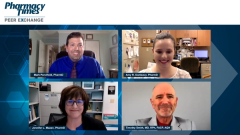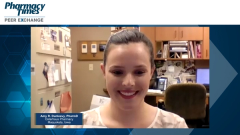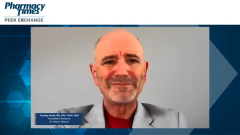
Migraine Treatment Limitations
Timothy Smith, MD, RPh, FACP, AQH, describes goals of therapy for the acute treatment of migraine and reacts to current treatment limitations associated with available drug therapies.
Episodes in this series

Mark Percifield, PharmD: There seems to be a lot of options and classes of medication that can be used. Unfortunately, there are a lot of unmet needs of traditionally acute reacting therapies for migraine. Timothy, what are the goals of acute treatment for migraine?
Timothy Smith, MD, RPh, FACP, AQH:When we talk about acute therapies—the American Headache Society and the FDA and patient groups, when they have been polled, indicate that the goal of therapy should be complete freedom from pain within 2 hours of dosing. That’s intuitive. We know that patients want to be pain-free. That’s the greatest predictor of improvement and functionality: complete freedom from pain. We also seek freedom from pain associated with light, noise, sensitivity, and nausea with or without vomiting. The interesting thing is that many times patients don’t achieve that freedom from pain in 2 hours very effectively. That leaves us with 1 of the great unmet needs of some of the traditional therapies. It’s a fact that the triptans have been a godsend for many. They’ve been the gold standard for almost 3 decades, and thankfully we’ve had that to make a great impact on patients’ lives. Those of our colleagues who are as old as I am or older will remember the days when all we had was prescriptions for opioids and ergots.
The triptans were a great addition, but there are many contraindications to them, including cardiovascular risk factors. Many patients don’t tolerate them. Many don’t get that 2 hour pain relief or freedom from pain within 2 hours. Some have drug interactions or other contraindications when using them. That leaves us with quite a bit of unmet need. One thing that happens in clinical setting is that physicians may ask the patient, “How is your medication working?” The patient might respond, “It’s working fine,” but they don’t really understand what that means. Many times, what the patient is saying is, “It takes the edge off, and I can get through the workday before going home and crashing and trying to sleep off that headache.” What physicians should be asking is, “Do you get complete relief in 2 hours?” If patients don’t, doctors should reevaluate other options, especially now that there are newer therapies coming on the market and that are on the horizon.
Mark Percifield, PharmD: Would you provide a percentage of patients who don’t experience adequate relief with these agents?
Timothy Smith, MD, RPh, FACP, AQH:Studies show that over 50% of patients who receive a prescription of triptans do not refill them after the first time within a year. That could be because they’re not getting adequate benefits. They could be having adverse effects. We don’t know the reasons why. It could be that they have cost coverages. Maybe they have high co-pay expenses and the like. Whatever the reason, you’d think that if patients really got a strong benefit from them, they’d refill those, but the fulfillment rate is low. Patients are procrastinating when they have them. Over 40% don’t take them within an hour of migraine onset, and that compromises their effectiveness even more. They are probably not appropriately used when they’re used, and we know that patients don’t refill them for various reasons. There are quite a bit of unmet needs still out there.
Transcript edited for clarity.
Newsletter
Stay informed on drug updates, treatment guidelines, and pharmacy practice trends—subscribe to Pharmacy Times for weekly clinical insights.

















































































































































































































